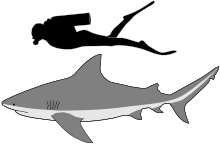Our website is made possible by displaying online advertisements to our visitors.
Please consider supporting us by disabling your ad blocker.
Bull shark
| Bull shark Temporal range: [1]
| |
|---|---|

| |
| Bull shark washed up on shore | |

| |
| Size compared to an average human diver | |
| Scientific classification | |
| Domain: | Eukaryota |
| Kingdom: | Animalia |
| Phylum: | Chordata |
| Class: | Chondrichthyes |
| Subclass: | Elasmobranchii |
| Order: | Carcharhiniformes |
| Family: | Carcharhinidae |
| Genus: | Carcharhinus |
| Species: | C. leucas
|
| Binomial name | |
| Carcharhinus leucas (J. P. Müller & Henle, 1839)
| |

| |
| Range of bull shark | |
The bull shark (Carcharhinus leucas), also known as the Zambezi shark (informally zambi) in Africa and Lake Nicaragua shark in Nicaragua, is a species of requiem shark commonly found worldwide in warm, shallow waters along coasts and in rivers. It is known for its aggressive nature, and presence mainly in warm, shallow brackish and freshwater systems including estuaries and (usually) lower reaches of rivers. Their aggressive nature has led to ongoing shark-culling efforts near beaches to protect beachgoers, which is one of the causes of bull shark populations continuing to decrease. Bull sharks are currently listed as vulnerable on the IUCN Red List.[3]
Bull sharks are euryhaline and can thrive in both salt and fresh water. They are known to travel far up rivers, and have been known to travel up the Mississippi River as far as Alton, Illinois,[4] about 1,100 kilometres (700 mi) from the ocean, but few freshwater interactions with humans have been recorded. Larger-sized bull sharks are probably responsible for the majority of nearshore shark attacks, including many incidents of shark bites attributed to other species.[5]
Unlike the river sharks of the genus Glyphis, bull sharks are not true freshwater sharks, despite their ability to survive in freshwater habitats.
This shark appears in the image of the 2000 colones bill from Costa Rica.
- ^ "Fossil Works". Fossilworks.org.
- ^ Rigby, C.L.; Espinoza, M.; Derrick, D.; Pacoureau, N.; Dicken, M. (2021). "Carcharhinus leucas". IUCN Red List of Threatened Species. 2021: e.T39372A2910670. doi:10.2305/IUCN.UK.2021-2.RLTS.T39372A2910670.en. Retrieved 19 November 2021.
- ^ Cite error: The named reference
:0was invoked but never defined (see the help page). - ^ Sharks In Illinois. In-Fisherman (16 July 2012). Retrieved on 30 November 2013.
- ^ "Bull shark". Florida Museum of Natural History. Retrieved 8 September 2006.
Previous Page Next Page



